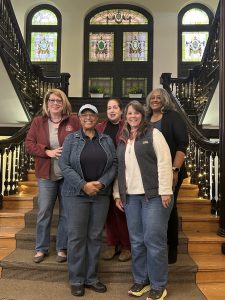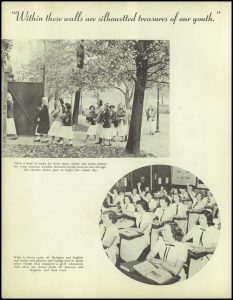There are a few rules Seton High graduates remember from the Catholic school’s historic building on Charles Street in Baltimore: Make sure to search for the World War I “doughboy” soldier in the stained-glass windows. Never use the main entrance (unless you’re late). Dare new students to find the fifth-floor swimming pool, and beware of Mother Seton’s grave in the underground tunnel that connected the campus’ main building with the sewing lab. (Neither pool nor crypt ever existed, but peeking through the fifth-floor transoms on tippy-toes provided a picturesque view of Baltimore.)

And above all, students must never use the golden stairs.
“When you walk through that front door and you see the golden stairs, you’re like, ‘Oh my gosh,’” says Joyce Trigger, Class of 1981, remembering that only seniors could take the stairs. “It’s still Seton. Your whole youth comes back. We didn’t think about it at the time, but the architecture is beautiful.”
Trigger and thousands of other Seton alumnae are celebrating the building’s history and iconic architecture ahead of a renovation beginning this spring that will transform the space into a hub for research and collaboration for the Johns Hopkins School of Education. The Education Building renovation will span 77,000 square feet of existing space to redesign classrooms to accommodate larger class sizes, create a recording and visualization studio for online and virtual learning platforms, and establish shared space for collaboration and community use.
The School of Education has partnered with Seton’s alumnae community in the months leading up to the renovation, including meeting with graduates, giving tours, and hosting a class reunion. Built in 1865 as St. Joseph’s School of Industry, Seton took over the building in 1928, and the school grew in prominence with an enrollment of 1,200 girls from more than 70 parishes in its heydays of the 1950s and 1960s, according to the Baltimore Sun.
When enrollments dwindled to as few as 350 students in the 1980s, the school was forced to shut its doors in 1988, and the building was converted to offices. Johns Hopkins bought the building in 2003 and restored it to its original purpose reopening it as the Graduate Division of Education in 2006. The School of Education was established as its own graduate school in 2007.
“This is a beloved school building. It’s a historic building in Charles Village that’s been dedicated to education since its inception,” says Jennifer Pelton, the School of Education’s associate dean of external affairs for Development and Alumni Relations. “Hearing from the people who love this building became part of our passion ahead of this renovation. Their stories bring the building to life, and we’re committed to preserving its history.”

This major renovation will maintain many of the building’s most beloved features, including the red-brick and red stone façade, the classic architecture, the stained glass, and the grand, three-story staircase.
“The golden stairs are gorgeous. The woodwork, the black and white tile floor,” says Colleen McCloskey, Class of 1982. “I think it’s fantastic to preserve and restore it as opposed to just remodeling it. Keeping the integrity of some of the architectural features is important, not just from a Seton graduate perspective, but from a Baltimore history perspective.”
Linda Pennington, Class of 1972, fell in love with the school years before she enrolled, thanks to Seton’s musicals. She was excited to play a part in them and auditioned for the orchestra during her freshman year ahead of a run of My Fair Lady.
“Those were some fun times,” she says. “We weren’t Baltimore Symphony Orchestra quality. But we tried, and we were very, very proud. We really thought we sounded good.”
Pennington’s sister, Carol Hamer, Class of 1980, matriculated eight years after Pennington. She says she was surprised that many parts of the building, especially the doorways and hallways along the second floor, have remained the same.
“We titled our 1980 yearbook, the Setonea, ‘Doorways and Stairways’ because it was all about the doors that we went through and the stairways that we took to our different classrooms,” Hamer says. “You can look up at that transom and go right back to 10th grade.”
Trigger maintains the best four years of her life were spent in Seton’s halls. She made lifelong friendships, and many of the alumnae are still in contact, regardless of graduation year. That’s the thing about Seton, the alumnae agree. It’s a tight-knit community.
And thanks to the renovation, the Education Building will continue to foster a sense of togetherness and belonging.
“The building will foster a vibrant community, combining academics and research centers and fostering collaboration with faculty, students, staff and alumni,” Pelton says. “We look forward to welcoming the greater Baltimore education community and everyone who loves this building.”
Topics: Alumni, Faculty and Staff, School of Education, Fuel Discovery, Strengthening Partnerships